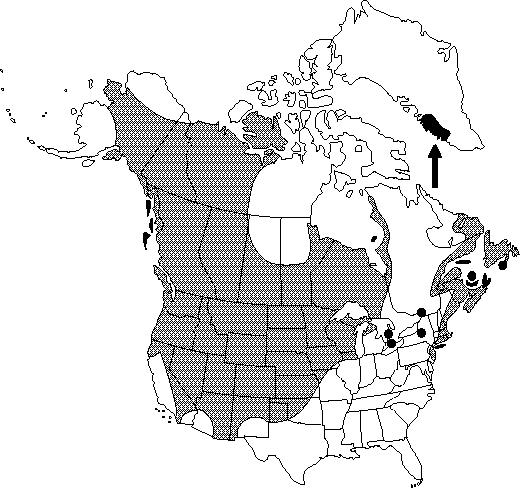Ranunculus cymbalaria
Fl. Amer. Sept. 2: 392. 1814.
Stems dimorphic, flowering stems erect or ascending, stolons prostrate, rooting nodally, glabrous or sparsely hirsute, not bulbous-based. Tuberous roots absent. Basal leaves simple and undivided, blades oblong to cordate or circular, 0.7-3.8 × 0.8-3.2 cm, base rounded to cordate, margins crenate or crenate-serrate, apex rounded. Flowers: receptacle hispid or glabrous; sepals spreading, 2.5-6 × 1.5-3 mm, glabrous; petals 5, yellow, 2-7 × 1-3 mm. Heads of achenes long-ovoid or cylindric, 6-12 × 4-5(-9) mm; achenes 1-1.4(-2.2) × 0.8-1.2 mm, glabrous; beak persistent, conic, straight, 0.1-0.2 mm. 2n = 16.
Phenology: Flowering late spring–summer (May–Sep).
Habitat: Bogs;marshes;ditches;stream banks;often saline
Elevation: 0-3100 m
Distribution

Greenland, St. Pierre and Miquelon, Alta., B.C., Man., N.B., Nfld. and Labr., N.W.T., N.S., Nunavut, Ont., P.E.I., Que., Sask., Yukon, Alaska, Ariz., Calif., Colo., Conn., Idaho, Ill., Iowa, Kans., Maine, Mass., Mich., Minn., Mo., Mont., Nebr., Nev., N.H., N.J., N.Mex., N.Y., N.Dak., Okla., Oreg., R.I., S.Dak., Tex., Utah, Wash., Wis., Wyo., Mexico, South America, Eurasia.
Discussion
Various Navaho groups used Ranunculus cymbalaria as a venereal aid, an emetic, and a ceremonial medicine. The Kawaiisu used it as a dermatological aid (D. E. Moerman 1986).
Selected References
None.
